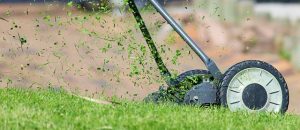Expert Guide to Planning, Installing, and Maintaining Eco-Friendly Patios and Walkways with Lawn Care Tips
When planning and installing a patio or walkway, strategic preparation is key to enhance your outdoo…….

When planning and installing a patio or walkway, strategic preparation is key to enhance your outdoor living experience and complement your home's design. Optimal location selection should consider sunlight, drainage, and privacy. Employ high-quality, weather-resistant materials like natural stone, concrete pavers, or brick that match your style and durability needs. Ensure the design includes spaces for seating and plant beds, with a layout that facilitates easy movement and navigation. Ground preparation is crucial; the site must be leveled and compacted before installation. Add outdoor lighting, furniture, and plants to increase practicality and visual charm. Regular maintenance post-installation is essential, including sweeping, joint filling to prevent weeds, and applying a sealer annually for protection. Integrate these practices with comprehensive lawn care and landscaping, which involve consistent mowing, targeted fertilization, aerating, and avoiding excessive herbicide use to maintain a healthy, green lawn that complements your outdoor spaces and enhances your home's curb appeal. By diligently maintaining your patio, walkway, and lawn, you can create a beautifully landscaped yard that is both functional and enduring.
embark on transforming your outdoor space with expert guidance on patio and walkway installation. This comprehensive article, infused with lawn care and landscaping insights, navigates you through the best practices for planning, a detailed step-by-step guide for execution, and essential maintenance tips to maintain the splendor of your new addition. Enhance your home’s curb appeal and create an inviting retreat by mastering the art of outdoor design and upkeep.
- Best Practices for Planning Your Patio and Walkway Installation
- Step-by-Step Guide to Executing a Successful Patio and Walkway Project
- Maintenance Tips for Keeping Your Patio and Walkway in Prime Condition, Integrating Effective Lawn Care Practices
Best Practices for Planning Your Patio and Walkway Installation

When embarking on a patio or walkway installation, careful planning is key to achieving a space that complements your home and enhances your outdoor experience. To ensure a successful project, consider the following best practices in lawn care and landscaping. Firstly, assess your yard’s terrain and existing features to determine the optimal location for your new patio or walkway. Take accurate measurements and account for factors like sunlight exposure, drainage, and privacy. Selecting durable, weather-resistant materials that align with your aesthetic preferences will contribute to both functionality and visual appeal. Additionally, think about the flow of movement within the space and how it connects with other outdoor areas.
In terms of design, opt for a layout that facilitates easy navigation while also accommodating seating or plant beds. When it comes to materials, natural stone, concrete pavers, or brick are popular choices that offer both aesthetics and longevity. Consider the scale and proportion of your patio or walkway in relation to your home and adjacent landscaping elements for a cohesive look. Proper preparation is crucial; ensure the ground is leveled and compacted before laying any materials. Finally, incorporate elements like lighting, outdoor furniture, and greenery to complete your outdoor living space, enhancing both its functionality and curb appeal. By adhering to these planning principles, your patio or walkway installation will not only improve your lawn care and landscaping but also create an inviting and functional outdoor retreat for years to come.
Step-by-Step Guide to Executing a Successful Patio and Walkway Project

Embarking on a patio and walkway installation project can significantly enhance your outdoor living space, blending functionality with aesthetics. To achieve a successful outcome, careful planning and execution are key. Begin by assessing your lawn’s condition and terrain to determine the ideal location for your patio, considering sunlight exposure, privacy, and accessibility. Choose materials that complement both your home’s architectural style and the natural landscaping.
Once the site is selected, plan the layout, ensuring proper drainage and allowing for adequate space around structures and plants. Select high-quality pavers or concrete for a durable surface that withstands weather elements and foot traffic. Excavate the chosen area to the required depth, laying a stable base of gravel or crushed stone. Compact this foundation to prevent settling. Install edge restraints to maintain the patio’s shape and prevent spreading or shifting of materials.
Lay the pavers or poured concrete in your desired pattern, ensuring each unit is level and properly spaced for joints. For walkways, consider a less intricate design for easier maintenance. After the installation is complete, sweep away excess sand or debris and prepare a mixture of mortar or sand for the joints between the paving stones. Carefully fill these spaces, sweeping the material into the cracks and striking it firmly with a broom to ensure a tight fit that prevents weeds.
Throughout the project, lawn care practices such as regular mowing, fertilization, and weed control around the new patio and walkway will maintain the surrounding area’s health and beauty, enhancing the overall curb appeal of your property. Remember to follow local building codes and obtain any necessary permits before beginning construction. With meticulous attention to detail and a commitment to quality, your patio and walkway will serve as a lasting addition to your landscaped outdoor space.
Maintenance Tips for Keeping Your Patio and Walkway in Prime Condition, Integrating Effective Lawn Care Practices

Engaging in regular maintenance of your patio and walkway not only extends their lifespan but also ensures they remain safe, inviting spaces within your landscape. To keep your outdoor living areas in prime condition, it’s crucial to regularly sweep away debris that can cause wear and tear over time. Employ a stiff-bristled broom to remove dirt, leaves, or grass clippings that might accumulate, especially after seasons of heavy rain or during fall cleanup. For patios made from materials like concrete or stone, applying a sealer annually can protect against stains and weather damage, enhancing their durability and visual appeal. In terms of walkways, ensure they are level to prevent tripping hazards and repair any cracks immediately to maintain safety.
Integrating effective lawn care practices with your patio and walkway maintenance creates a cohesive outdoor environment that is both functional and aesthetically pleasing. Regular mowing at the appropriate height for your grass type can encourage healthy root growth and reduce weed competition. Aerating your lawn periodically helps soil compaction, allowing air, water, and nutrients to penetrate the roots more easily. Additionally, proper fertilization tailored to your local soil conditions and grass variety promotes lush, green turf that complements your outdoor living areas. Overuse of herbicides should be avoided as it can harm the surrounding lawn and affect beneficial insects. By combining thoughtful lawn care with meticulous patio and walkway maintenance, you’ll create an outdoor sanctuary that’s both functional and beautiful, enhancing your home’s curb appeal and providing a serene retreat for years to come.
In wrapping up our exploration of creating inviting and functional outdoor spaces with a focus on patio and walkway installation, it’s clear that thoughtful planning, meticulous execution, and diligent maintenance are key to achieving long-lasting beauty and usability. By adhering to the best practices outlined in this article, readers can transform their outdoor areas into tranquil retreats or vibrant entertainment hubs. Our step-by-step guide has provided a comprehensive roadmap for successful project implementation, ensuring that every element from material selection to design layout aligns with your vision and lifestyle needs. Furthermore, integrating effective lawn care practices as part of the maintenance strategy will not only enhance the overall aesthetic but also contribute to the longevity and health of your outdoor spaces. For those looking to elevate their property’s appeal, embracing lawn care and landscaping best practices is an investment that yields both immediate enjoyment and long-term value.







